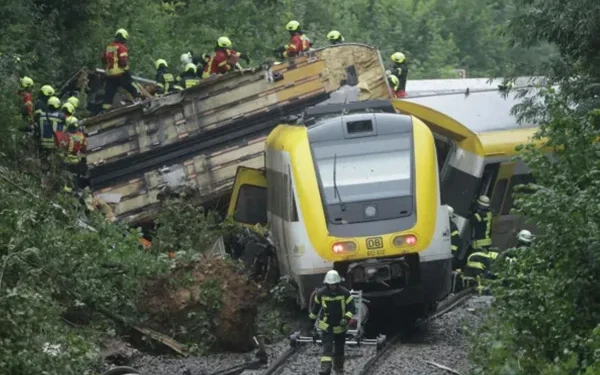BERLIN — In a tragic incident that has sent shockwaves across Germany and Europe, a passenger train derailed in the southwestern region of the country, resulting in the deaths of three individuals and leaving several others injured. The accident occurred on a regional rail route between the cities of Sigmaringen and Ulm, triggering a massive emergency response and reigniting public concerns over railway safety.
Overview of the Incident
The train derailment took place early Monday morning as a passenger train was en route on the 90-kilometer stretch connecting Sigmaringen and Ulm, a scenic but relatively quiet region known for its dense forests and hilly terrain. According to the German news agency DPA, two coaches of the train derailed under circumstances that are still being investigated.
A police spokesman from Stuttgart, one of the major cities in southern Germany, confirmed the casualties: “Three people were pronounced dead at the scene, and a significant number of passengers have sustained various degrees of injuries.” Emergency services, including police, paramedics, and firefighters, were dispatched to the scene promptly after the incident was reported.
Chancellor Friedrich Merz Responds
German Chancellor Friedrich Merz expressed profound grief over the tragic event. Taking to social media platform X (formerly Twitter), he wrote:
“Shocked and saddened by the loss of lives in the train accident in the southwest. My thoughts are with the victims and their families. We are in constant contact with our Interior and Transport Ministries to ensure immediate assistance and a full investigation.”
Merz emphasized that he had issued strict instructions to provide emergency medical aid, psychological support to survivors, and logistical help to those affected by the transport disruption.
Location and Train Route Details
The accident occurred on the regional rail line running between Sigmaringen, a historic town in Baden-Württemberg, and the city of Ulm, located at the confluence of the Danube and Iller rivers. The route is operated primarily by Deutsche Bahn, Germany’s national railway company, and serves as a vital connector for both daily commuters and tourists.
The area is known for its rugged topography, which poses challenges for rail infrastructure, especially in adverse weather conditions. The train involved in the accident was a standard regional service, frequently used by students, workers, and tourists traveling between the two cities.
Emergency Response and Rescue Operation
Within minutes of the derailment, emergency units rushed to the accident site. The rescue operation involved helicopters, ambulances, mobile medical units, and heavy-duty machinery to help extricate passengers trapped inside the overturned coaches. More than 100 rescue personnel participated in the operation, and temporary shelters were set up nearby for uninjured passengers and family members arriving at the scene.
Eyewitnesses described scenes of panic and chaos. “We felt a massive jolt and then the coach tilted sharply to one side,” said one passenger. “People were screaming and trying to get out through broken windows.”
Injuries and Medical Care
While the identities of the deceased have not been officially disclosed, authorities confirmed that they included both male and female passengers, possibly from different age groups. At least 30 individuals were reported to have been injured, with some in critical condition.
Local hospitals in Ulm and Sigmaringen were put on high alert, with emergency wards prepared to receive patients. The Ministry of Health announced that medical staff were working round the clock to ensure the best possible care for the injured.
Investigation and Preliminary Causes
Authorities have launched a full-scale investigation to determine the cause of the derailment. The German Federal Railway Authority (Eisenbahn-Bundesamt) and the State Transport Police are leading the inquiry, supported by forensic engineers and safety experts.
Preliminary reports suggest that mechanical failure, faulty rail infrastructure, or a possible landslide triggered by recent rains could be contributing factors. Weather conditions at the time of the accident were reportedly cloudy with light rain, but not severe enough to immediately raise red flags.
Experts are also examining whether there were any lapses in routine track maintenance or signaling errors that could have caused or exacerbated the derailment.
Deutsche Bahn’s Statement and Ongoing Measures
Deutsche Bahn, Germany’s national railway operator, issued an official statement expressing deep sorrow over the incident:
“We are deeply saddened by the tragic derailment of one of our regional trains. Our hearts go out to the victims and their families. We are cooperating fully with the authorities to investigate the cause of this accident and will do everything possible to support those affected.”
The company has set up an emergency hotline for families of the victims and passengers and has suspended train services along the affected route until further notice.
Rail Safety Under the Spotlight
Germany, known for its highly efficient and advanced rail network, has seen relatively few major train accidents in recent decades. However, this incident brings back painful memories of the 2016 Bad Aibling train crash in Bavaria, where two passenger trains collided head-on, killing 12 people and injuring over 80.
Following that incident, reforms were introduced to enhance communication systems and track safety. Nevertheless, experts now argue that more investments are required to modernize infrastructure, especially on regional and rural routes that are often overlooked in favor of high-speed intercity lines.
Public Reaction and Social Media Outpouring
The accident has stirred widespread public mourning and debate. Social media platforms have been flooded with messages of condolence, support for the victims, and calls for enhanced rail safety.
A user on X posted, “This is heartbreaking. The train system is our pride, but we can’t afford to be complacent. Lives are at stake.”
Others questioned whether austerity measures and budget cuts to transport infrastructure over the past years may have contributed to safety lapses.
Transport Ministry and Political Reactions
Federal Minister of Transport, Volker Wissing, visited the accident site later in the day and promised a comprehensive review of rail safety procedures. “We will leave no stone unturned in understanding how this happened,” Wissing stated. “The safety of our rail passengers is non-negotiable.”
Several members of the Bundestag, including opposition lawmakers, have called for an emergency parliamentary session to review the current state of the national rail infrastructure and assess funding needs.
Support Services for Victims and Families
In coordination with local authorities, counseling services are being provided to survivors and family members. Non-governmental organizations, including the German Red Cross, have mobilized their crisis response teams to offer psychological support and legal assistance.
Temporary accommodations are also being arranged for stranded passengers who were en route to other destinations, while alternative travel arrangements such as bus transfers are being facilitated.
What Happens Next?
The coming days will likely see continued investigations, safety audits, and political discussions. Families will grieve and seek answers, while railway officials and government agencies will need to demonstrate accountability and transparency.
Authorities have promised a preliminary investigation report within 10 days, followed by a full technical review. Any findings of negligence or mechanical failure could lead to legal action and policy reforms.
Conclusion
The train accident in southwestern Germany serves as a grim reminder that even in countries with some of the world’s best transportation systems, tragic failures can still occur. As the nation mourns the loss of life, attention is now focused on understanding the root causes of the derailment and ensuring such a catastrophe never happens again.
Keywords for SEO: Germany train derailment, Sigmaringen Ulm rail accident, German railway safety, Deutsche Bahn crash, Friedrich Merz train accident statement, regional train crash Germany, 2025 German train disaster, rail infrastructure Germany, emergency response train accident.

























